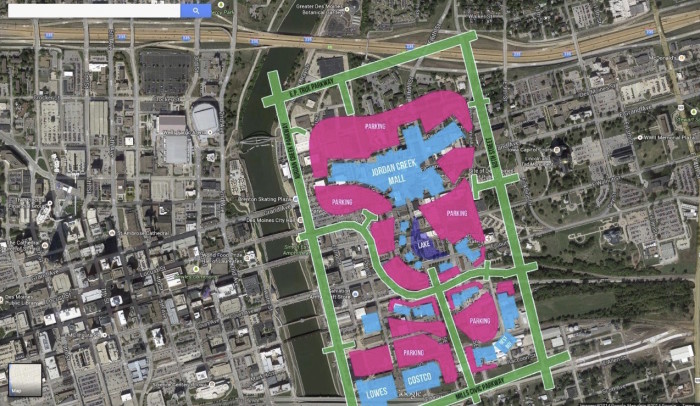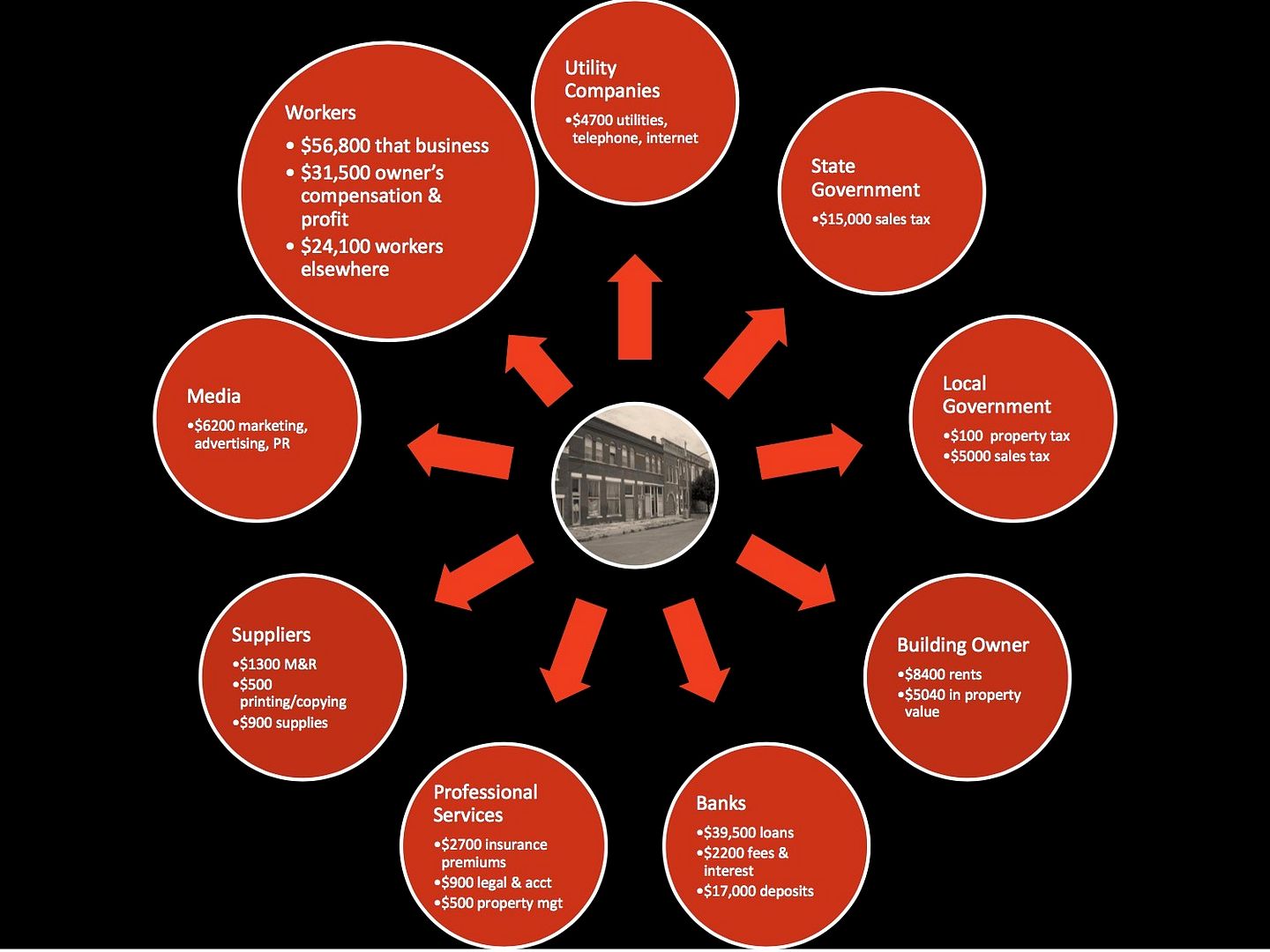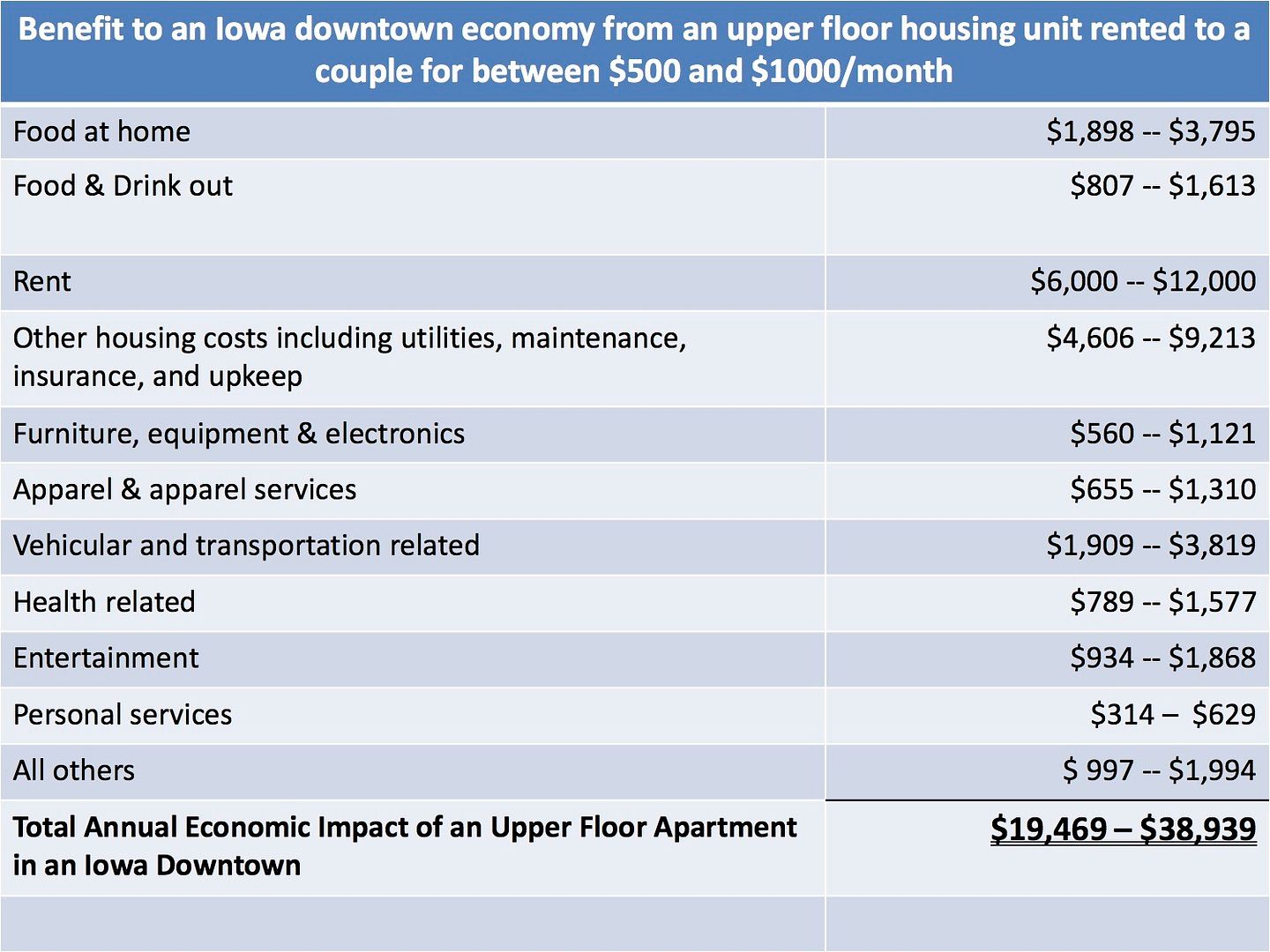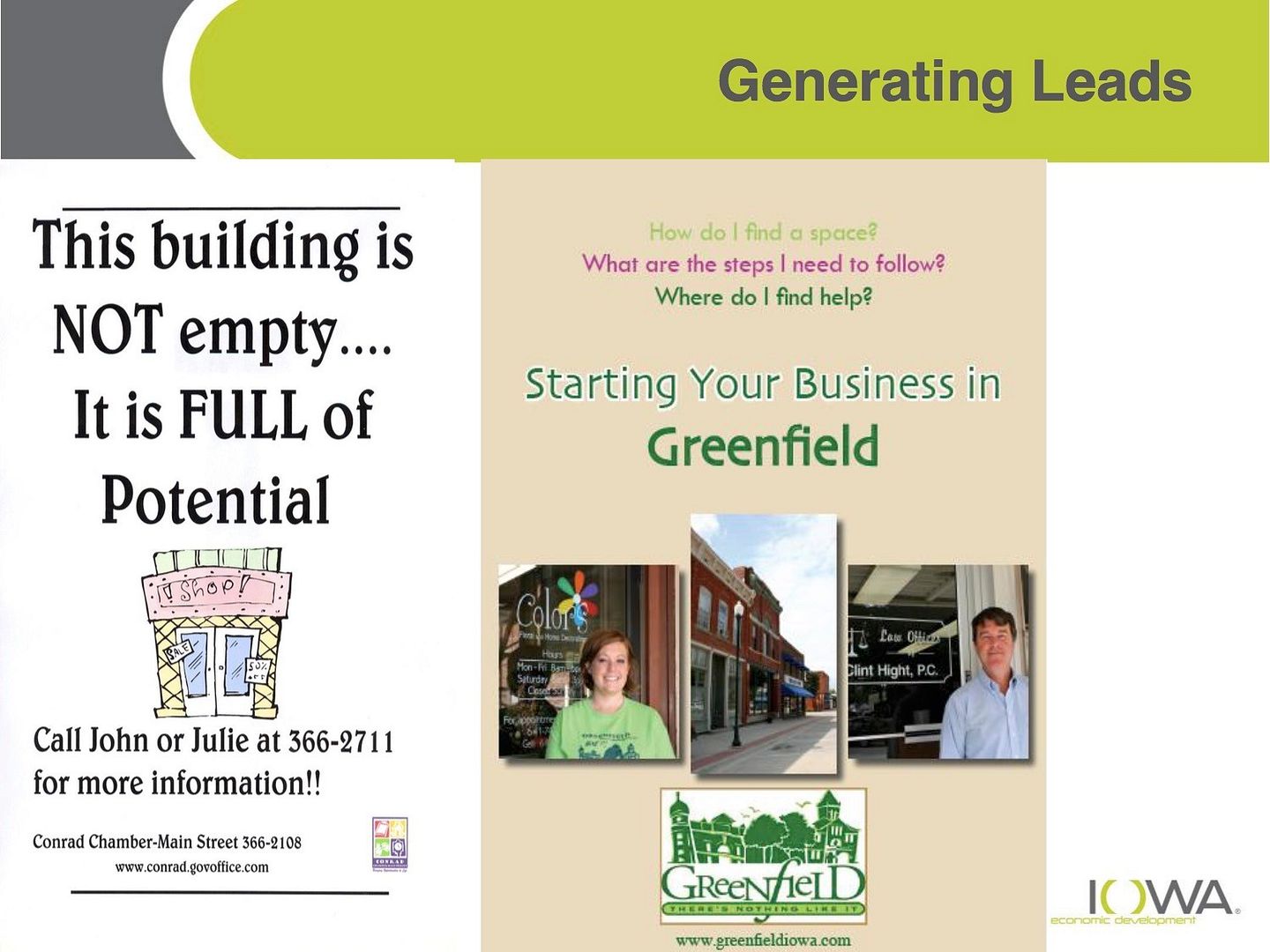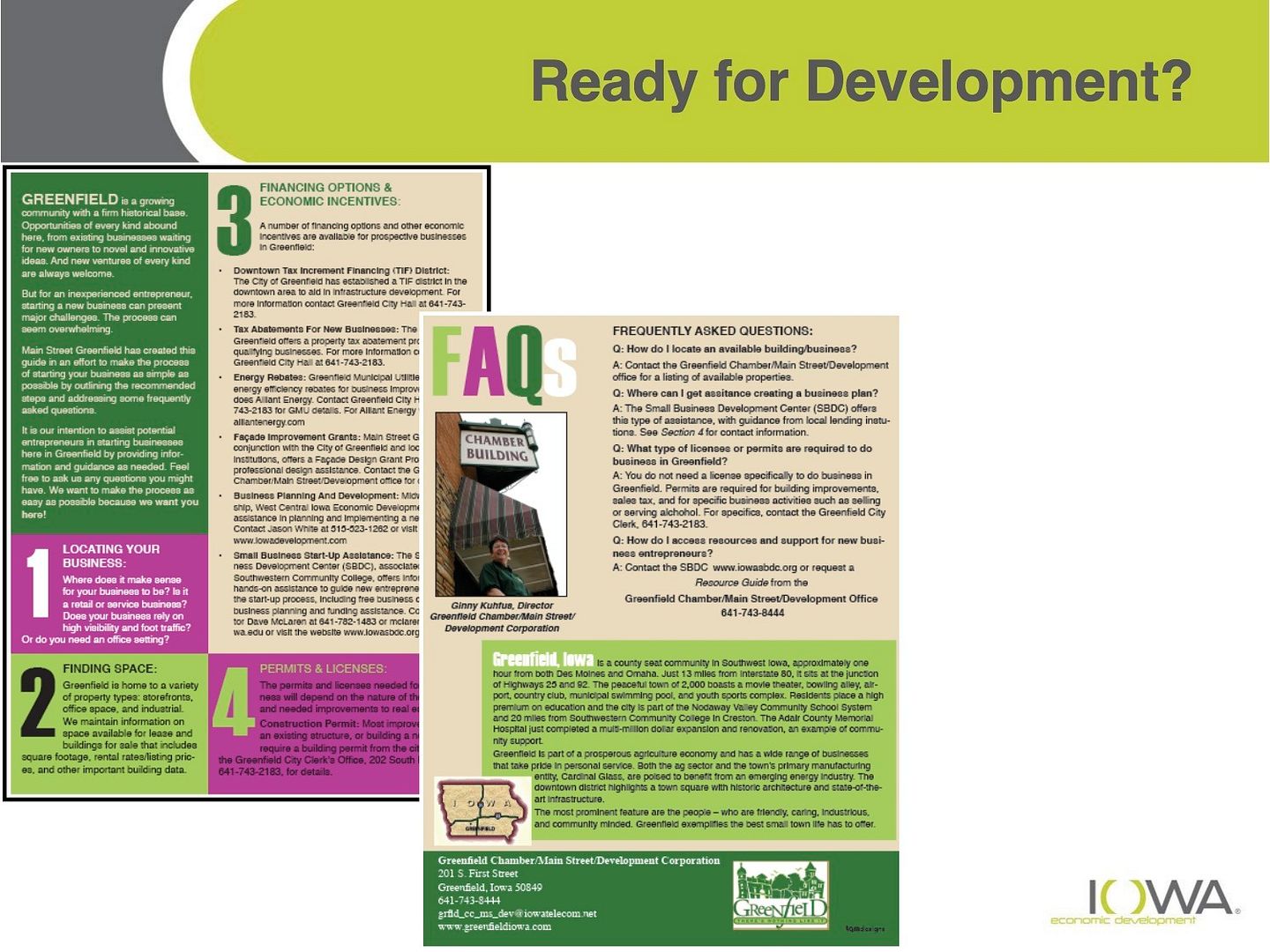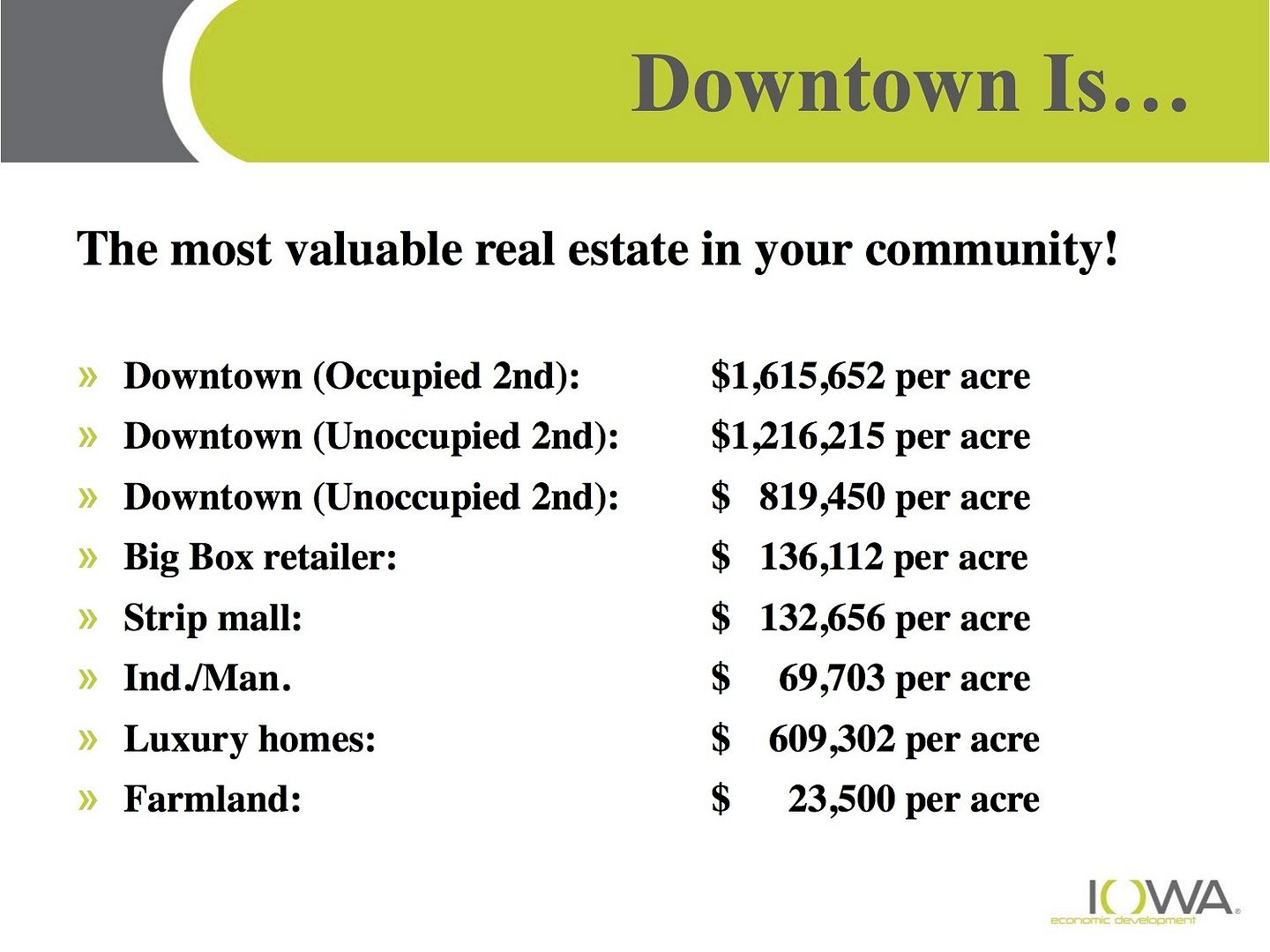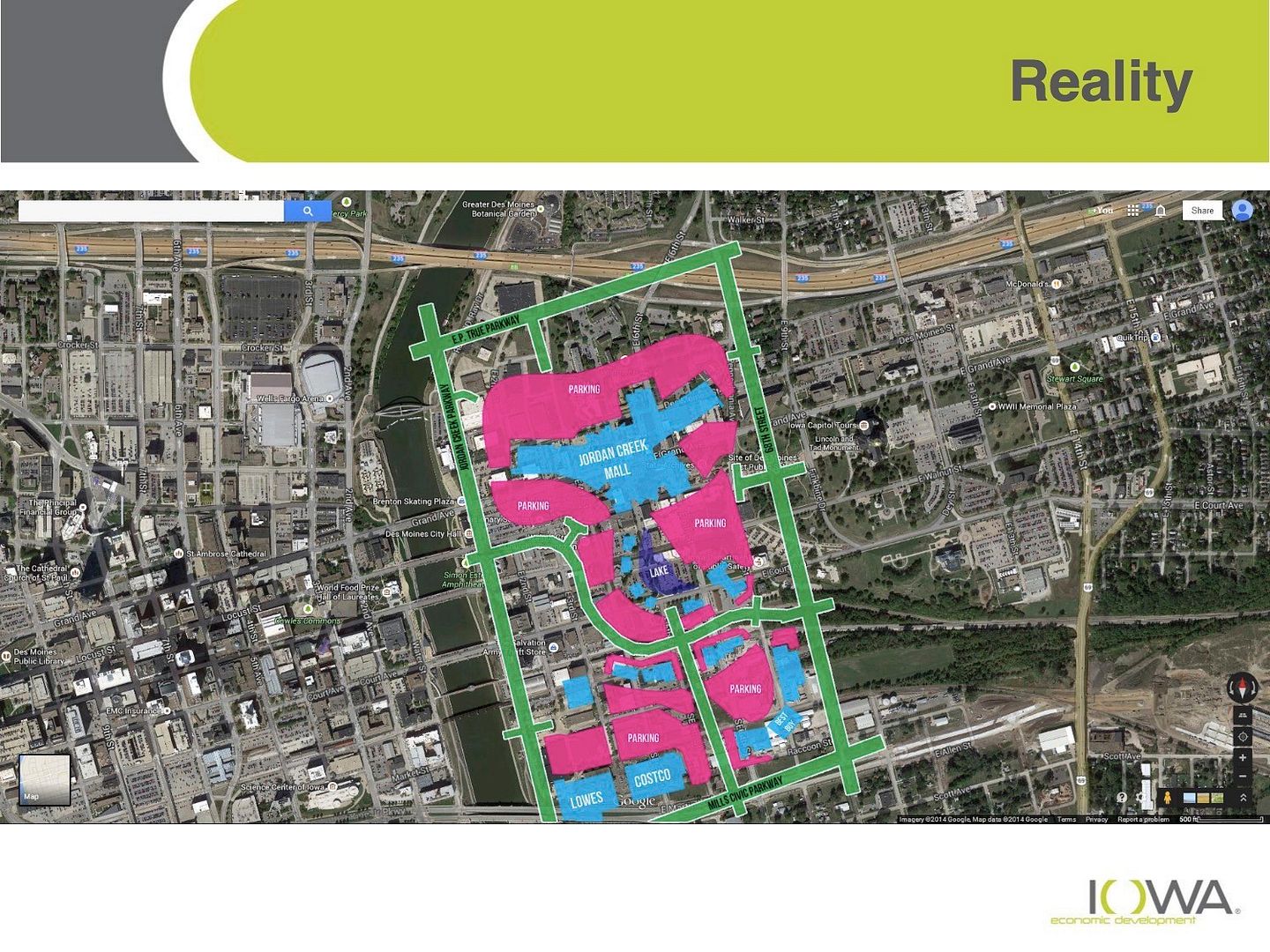“Footprint” of Jordan Creek Town Center development in West Des Moines, overlaid on the “East Village” neighborhood of downtown Des Moines, courtesy of Jim Thompson
Four of the oldest buildings in downtown Waterloo “have been renovated with their historic features revived,” John Molseed reported for the Waterloo-Cedar Falls Courier on May 13. A block that had been vacant since 2007 will now hold “four commercial spaces and six loft-style apartments.” The city of Waterloo and the state historic tax credit program helped secure private investment for the project.
Renovating older buildings is much better for the environment than razing them. The economic benefits of historic preservation are not always easy to measure, but converting vacant buildings to commercial or residential use generates revenue.
Downtown property is the most valuable per acre, according to data compiled by Jim Thompson, a business specialist for the Iowa Economic Development Authority’s Main Street Program. For that reason, Thompson advises anyone who will listen, “If you want to help your school districts, invest in your downtown buildings.”
His message should resonate with local officials after yet another state legislative session produced a disappointing budget for K-12 schools. With Thompson’s permission, I enclose below some materials he has created to show the impact of repurposing downtown buildings.
These slides and graphics were part of Thompson’s keynote presentation at the 1000 Friends of Iowa annual meeting in December 2015. I highly recommend Thompson as a guest speaker for any city council, chamber of commerce, or community group. Thanks to his passion for his work, his remarks were much more entertaining than you’d expect from a fact-filled talk about business recruitment and multiplier effects. Thompson led the Main Street program and Chamber of Commerce in Charles City (Floyd County) for six years before joining the state economic development agency’s Main Street program in 2007.
Jim assists communities in all areas of downtown retail and comercial economic development. He oversees all aspects of market analysis including data analysis, business retention, recruitment, and implementation strategies. He has also led efforts in branding and one-on-one business technical assistance for Iowa’s Main Street communities. […] He has over 25 years experience in community development, retail management as well as having served on the City Council for 10 years. Jim has served as a consultant for the National Main Street Center and has presented multiple times at the National Main Streets Conference.
The Main Street program has involved 70 Iowa communities at one time or another since its creation 30 years ago. Currently 53 cities and towns are in the Main Street program. To be included, applicants need to show “strong partnerships, a high level of volunteerism and a commitment to the revitalization of their downtown districts.”
While it may be challenging to become a Main Street community, designated communities reap many benefits. During the first three years of the program, each community receives approximately 40 days of on-site training and technical assistance from Main Street Iowa, National Main Street Center staff and private consultants, as well as 30 days of training for volunteers and local staff, valued at $120,000. Main Street communities each receive continuing training and technical assistance valued at $10,000+ annually.
Speaking to 1000 Friends of Iowa members, Thompson argued that it’s a mistake for city leaders to focus on landing a “home run” smokestack project that would provide a large number of jobs. Creating the conditions for small businesses to thrive is a more effective approach, which also leaves communities less vulnerable to the whims of one large employer. Chipping away at unused available space downtown is one way to accomplish that goal.
Vacant buildings are a familiar sight in many Iowa town centers. Not only are they eyesores and sometimes public safety hazards, each vacant property downtown represents some $220,000 in lost revenue, according to Thompson–more in cities with higher rents. Here’s how putting a business into a typical unoccupied building produces revenue:
Thompson spoke about housing as “the number one determinant of economic development in a community.” Housing inventory is an amenity, and inadequate housing stock is hurting Iowa, in Thompson’s opinion. He also emphasized that there is demand for downtown living space in small towns as well as larger cities.
Some years ago, then Main Street Program Director Thom Guzman told 1000 Friends of Iowa members about a “3 percent rule”: in a community of any size, roughly 3 percent of residents would like to live downtown if suitable space were available for rent. So, in a town of 1,000 residents, there are probably enough people to occupy some 30 apartments on the upper floors of downtown buildings. A city with 10,000 people could likely support enough downtown housing to accommodate 300 inhabitants. I asked Thompson about that rule of thumb. He said recent research suggests more than 3 percent of people desire to live in town centers.
Many downtown renovation projects are “mixed use,” with commercial property on the ground floor and housing above. One upper-floor apartment with two residents can generate nearly $20,000 to $40,00 per year in consumer spending. This slide shows the breakdown:
Vacant properties don’t magically fill themselves. Successful communities have engaged public officials and chambers of commerce in recruiting business owners to open up shop in empty space downtown. Thompson shared some examples of materials used in Conrad (Grundy County), Greenfield (Adair County), and Charles City (Floyd County). Incidentally, Greenfield is only about an hour’s drive from the Des Moines area and has done incredible things with its town center. The Hotel Greenfield project won one of 1000 Friends of Iowa’s Best Development Awards in 2013, and the town’s restored opera house is arguably more impressive. (Disclosure: I serve on the board of directors for 1000 Friends of Iowa but play no role in selecting the Best Development Award winners.) The Iowa Aviation Museum is about a mile north of Greenfield and a fun destination for airplane history buffs.
I have not visited Charles City, but that town has been recognized for its multi-faceted riverfront development, including a whitewater attraction for paddlers.
A big takeaway from Thompson’s presentation was that downtown property is the most valuable real estate. Developing an acre downtown, especially for a project that includes housing or offices above ground-level businesses, will generate more revenue for a city than an acre used for a strip mall, a “big box” retail store, industrial or manufacturing property, or luxury homes. This idea may be counter-intuitive to many city officials, who are often eager to approve tax incentives for developers to build “McMansions” or new retail stores on the edge of town. They might better direct their energy toward finding investors to fix up crumbling old buildings. This chart crunches the numbers for a relatively large and prosperous community, Cedar Fails in Black Hawk County.
This chart shows similar data for the small town of Woodbine in Harrison County.
Woodbine won 1000 Friends of Iowa’s leadership award in 2014, in recognition of phenomenal work by locals to improve the town center.
The work began in 2007 when the western Iowa town of 1,500 residents acknowledged their downtown, comprised of three square blocks with 10 vacant and decaying buildings, must be addressed. Prioritizing collaboration, pursuing diverse funding sources and accomplishing project after project has enabled Woodbine to reap the economic and community-building benefits of revitalizing existing assets.
Here are a few examples of Woodbine Main Street District accomplishments:
• 2008 Designated an Iowa Economic Development Authority Green Pilot Community receiving energy audits and incentive programs
• 2009 Commissioned a Sustainable Community Master Plan
• 2010 Received Community Development Block Grant (CDBG) Downtown Revitalization Funds for Façade Master Plan ($500,000)
• 2010 Received Main Street Iowa I-Jobs Grant for Main Street renovations, grain elevator public art project, and outdoor amphitheater ($490,000)
• 2011 Received CDBG for six upper-story housing grayfield projects ($543,000)
• 2012 Designated an Iowa Blue Zone Project Small Population Pilot Community
• 2013 Designated National Register Historic District: The Woodbine Lincoln Highway and Brick Street Historic District
• 2014 Complete 2-year Economic and Behavior Impact Study of Sustainable Community Transformations
When Thompson speaks about the benefits of downtown development, a common point raised by naysayers is that people don’t want to visit shops or restaurants in town centers, because they might have to park their car a few blocks away. Iowans prefer malls or big box stores with ample parking nearby.
Thompson is convinced, “We don’t have parking problems–we have walking problems.” In addition, he made a strong case that some people’s mental block about parking downtown is ill-founded. In reality, visiting a shopping mall may involve just as much walking, if not more, to get where you’re going. My favorite visual aid from his presentation was this image of Jordan Creek Town Center in West Des Moines overlaid on a map of the “East Village” of Des Moines between the river and the state capitol complex.
Many Iowans who would balk at having to park a short walk from a downtown store or restaurant would think nothing of covering the same distance on foot when visiting a big mall in what I like to call “taupe town.”
Any relevant comments are welcome in this thread. Next time I’m in Waterloo, I hope to check out the redeveloped Walden Block.

